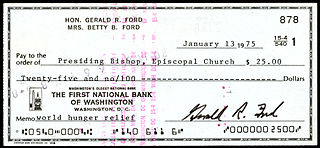Slow development due to legacy systems
In developed countries existing legacy banking systems and rules has slowed down the development of electronic billing. For example, in the United States financial institutions typically formally prohibit the use of their consumer electronic bill payment systems for payments to certain agencies such as: collection agencies, or recipients of court-ordered payments like child support or alimony. Any organizations or individuals outside of the United States are also usually excluded. Payments to government agencies for utilities such as water are usually permitted.
Electronic bill pay systems fall into two categories, "pay-anyone" services and restricted biller list services. In a pay-anyone service, the provider will facilitate a payment to the payee regardless of whether they have an electronic connection with that payee or not. If they cannot deliver the payment to the payee electronically, they will print and mail a paper check on the payer's behalf. The largest providers of electronic bill pay services can deliver about 80% of their payments electronically, so 20% of payments facilitated by the large pay-anyone services are still made by mailing a paper check to the biller. This is the primary reason why some billers in a pay-anyone service require as much as a 5-day lead time for the payment to reach the payee.
Restricted biller list payment services allow paying any biller in the provider's network, and in these services where the provider has an electronic relationship with the biller, the payments will be delivered electronically.
In 2022 Aite Novarica, has published a new state of the market research which provides interesting look on the Electronic Billing market in the US. Biller Direct EBPP Solutions the report mentions not only the legacy solutions but also new and innovative technologies and solutions. The report mentioned: ACI Worldwide, Alacriti, Aliaswire, Amazon, American Family, BillGo, BillingTree, Billtrust, BlytzPay, Canam Steel, CapitalOne, Comerica, County of Los Angeles, Dade Systems, Dominion Energy, Drive Time, Eversource, Excelon, Farmer's Insurance, Fifth-Third Bank, FIS, Fiserv, Georgia Power, Grameen America, High Radius, Internal Revenue Service, InvoiceCloud, John Hancock, KUBRA, Liberty Mutual Insurance, Mastercard, Miami-Dade County, Mint.com, Mitsubishi, Mountain America Credit Union, MyCheckFree.com, National Grid, NCR, New York Life Insurance, Nissan, Ohio Mutual Insurance, Oklahoma Wesleyan University, OneMain Financial, Opportun, Paymentech, Paymentus, PayNearMe, PayPal, PNC Bank, Point and Pay, Pulte Mortgage, QuickBooks, Repay, Santander, Solano County, California, Southwest Gas, State of California, Stripe, SWBC, TDBank, Technology Credit Union, Transactis, Uber, United Auto Credit, U.S. Bank, Veridian Credit Union, VPS, WageWorks, Wells Fargo, Westlake Financial, and Wyndam Vacation Rentals.





